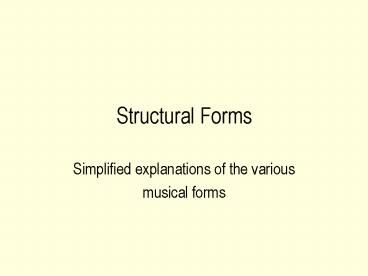Structural Forms - PowerPoint PPT Presentation
1 / 19
Title:
Structural Forms
Description:
which are combine to form larger patterns: figure figure = motive ... The simple two-part song form: Part I may be from a phrase to a double period in ... – PowerPoint PPT presentation
Number of Views:154
Avg rating:3.0/5.0
Title: Structural Forms
1
Structural Forms
- Simplified explanations of the various
- musical forms
2
Song Forms
- One part
- Simple two-part
- Expanded two-part
- Incipient three-part
- Three-part
- Enlarged three-part
- Five-part
- Free or group forms
3
(No Transcript)
4
Two-part song forms (or smallest binary forms)
- Two balancing divisions are analogous,
structurally, to the units - which are combine to form larger patterns
- figure figure motive
- motive motive semi-phrase
- semi-phrase semi-phrase phrase
- phrase phrase period
- period period double period
- The simple two-part song form Part I may be
from a phrase to a double period in length. The
cadence - at the end of Part I may be
- Authentic, in the tonic of the dominant
- Authentic, in the tonic of the related key
- Half cadence on the dominant
- Authentic in the original tonic
5
Phrase Groups/Periods
- Periods are either parallel or contrasting.
- In designating phrases the letters A, B, C, etc.
are used. - Four contrasting phrases would be A B C D.
- Two identical phrases following one another would
be A A B B C C, etc. - Four similar, but not identical, phrases would be
A A A A - Common types of parallel double periods are
- A A A A A A A B A B A B A B A C
6
Part I and Part II or Part A and B combine
to form a two-part binary form
- Part I may be from a phrase to a double
period in length. - Part II may also be from a phrase to a
double period in length. - Part II may be in the same key as Part I or
in a related key. - Final cadence is authentic in the original
tonic. - Often Parts I and II are identical in length
if not, Part II is - generally longer.
7
Binary Form (repeat possibilities)
/
/
Part I
Part II
/
Part I
Part II
Part I
Part II
Part I
Part I
8
Binary TypesSimple vs. Rounded
- Occasionally the B section will end with a
return of the opening material from the A
section. - This is referred to as rounded binary, and is
labeled as A B A - In rounded binary, the beginning of the B section
is sometimes referred to as the bridge. - Rounded binary contrasts with ternary form (ABA),
the difference is that the B section in ternary
form contrasts with the A material, i.e. minuet
and trio - If B section lacks a return of the A material, it
is conisidered simple binary.
9
Binary TypesSectional vs. Continuous
- If the A section ends with an Authentic (Perfect
or Imperfect) cadence in the tonic key, it is
referred to as a sectional binary. - If the A section ends with any other kind of
cadence, it is referred to as a continuous
binary. (The B section continues the new
established by the cadence at the end of the A
section.
10
Binary TypesSymmetrical vs. Asymmetrical
- If the A and B sections are roughly equal in
length, it is referred to as symmetrical - If the A and B sections are of unequal length,
the design is referred to as asymmetrical.
11
(No Transcript)
12
Understanding three part forms
When speaking of three-part forms, we often use
terms such As the three-part song form or ternary
form. We represent these forms in a simplified
manner, where A B A refers to one of the
distinctive parts of the piece or
movement. While we speak of a three-part
structure, and use the terms, Part I, Part II,
and Part III, the third part is not actually a
different part but is a restatement, exact or
somewhat modified, of Part I.
13
Ternary StructuresThe most frequently used
musical structure 1700-1900?
- Three-part period
- Incipient three-part song form
- Three-part song form
- Enlarged three-part song form
- Five-part song form
- Song form with trio
- Minuet and trio (song form with trio)
- First rondo form
- Second rondo form
- Third rondo form
- Sonatine
- Sonata-allegro
14
General three-part simple form Simple Ternary
A B A thematic return (A) after a digression
(B) A1 Statement B digression A2
return (or reprise) Three Part Patterns (but
not Ternary) A A A (series of strophes) A B C
additive A A B A B B
15
Linear Graphs for Ternary forms
16
Rondo FormsThree principal varieties most often
used
- First Rondo Form A B A
- Second Rondo Form A B A C A
- Third Rondo Form A B A C A B A
17
The First Rondo Form
- The principal theme (A) may be from a period to a
song form in length. - A transition or an episode may occur between the
principal them (A) and the subordinate theme (B). - The subordinate theme (B) is, with few
exceptions, in a related key or mode. The
subdominant however is the least favored.
18
The Second Rondo Form
In tonal music, the key relationship of the parts
is A B A C A Key 1 Key 2 Key 1 Key
3 Key 1
19
(No Transcript)































